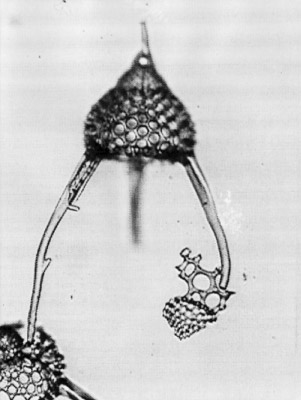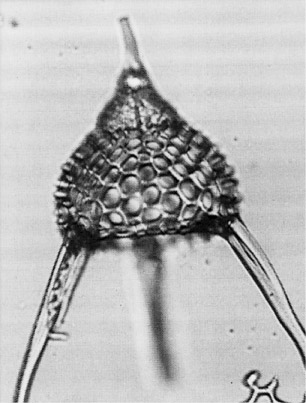 Thyrsocyrtis
(Pentalacorys) lochites Sanfilippo and Riedel
Thyrsocyrtis
(Pentalacorys) lochites Sanfilippo and Riedel Thyrsocyrtis
(Pentalacorys) lochites Sanfilippo and Riedel
Thyrsocyrtis
(Pentalacorys) lochites Sanfilippo and RiedelThyrsocyrtis (Pentalacorys) lochites Sanfilippo and Riedel, 1982, p.175, pl.1, fig.13, pl.3, figs. 5-9 (with synonymy)
General form broadly conical. Cephalis subspherical, with few small pores, bearing horn of the same length to several times the length. Thorax campanulate, with rather small pores. Lumbar stricture distinct. Abdomen inflated-annular, with pores similar to those of early representatives of T. triacantha -- 1.5-3 pore centers in 50 µm, 10-15 on a half-circumference. Peristome distinct. Feet bladed (at least proximally), originating above peristome, usually widely divergent but in some specimens subparallel (Sanfilippo and Riedel, 1982).
Based on 30 specimens. Total length excluding feet and horn 170-230 µm, of cephalothorax 65-90 µm, of abdomen 75-130 µm. Maximum width 155-220 µm (Sanfilippo and Riedel, 1982).
The bladed nature of the proximal part of the feet is associated with a ridge that extends between nearby abdominal pores, and subparallel to the peristome. The pores adjacent to the peristome are smaller than the other abdominal pores, which are smaller than those of co-occurring (late) T. triacantha.
 A
tendency for the feet to originate slightly above the peristome is observed also
in some specimens of T.
tensa and early T.
triacantha (in individuals with relatively small abdominal pores),
but these are included within the morphological variation of those species. Some
of the earliest specimens with features resembling T.
lochites (treated as variants of T.
tensa) have feet partly porous in the manner of T.
tarsipes. Three of these early variants of T.
tensa were noted by Foreman (1973, pl.3, figs.18-19; pl.12, fig.7),
who identified them simply as Thyrsocyrtis
sp. (Sanfilippo and Riedel, 1982).
A
tendency for the feet to originate slightly above the peristome is observed also
in some specimens of T.
tensa and early T.
triacantha (in individuals with relatively small abdominal pores),
but these are included within the morphological variation of those species. Some
of the earliest specimens with features resembling T.
lochites (treated as variants of T.
tensa) have feet partly porous in the manner of T.
tarsipes. Three of these early variants of T.
tensa were noted by Foreman (1973, pl.3, figs.18-19; pl.12, fig.7),
who identified them simply as Thyrsocyrtis
sp. (Sanfilippo and Riedel, 1982).
T. lochites accompanies T. triacantha, which it closely resembles, in the later part of its range, and then accompanies T. tetracantha. It differs from T. tensa and T. triacantha in the feet being bladed, at least proximally, and originating above the peristome (Sanfilippo et al., 1985).
A robust species, with inflated abdomen and large abdominal pores (10-12 pores across the half circumference). The peristome is distinct, sometimes with remnants of a fourth, very weak segment. Prominent bladed feet are widely divergent, in some specimens subparallel (Sanfilippo et al., 1985).
T. lochites occurs in late middle through late Eocene tropical assemblages. Its morphotypic first appearance lies within the Podocyrtis mitra Zone. Its morphotypic last appearance is approximately synchronous with the lower limit of the Cryptocarpium ornatum Zone.
T. lochites is an evolutionary offshoot from T. triacantha from which it arose by the origin of the feet becoming separated from the peristome. It did not leave any known descendants.